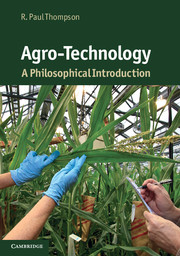Book contents
- Frontmatter
- Contents
- List of figures
- List of tables
- Preface
- Introduction
- 1 Scientific background
- 2 Application of genetics to agriculture
- 3 Philosophical and conceptual background
- 4 The controversy
- 5 The controversy
- 6 The controversy
- 7 The organic alternative
- 8 Impacts on low- and middle-income countries
- Concluding remarks
- Bibliography
- Index
1 - Scientific background
Published online by Cambridge University Press: 05 June 2012
- Frontmatter
- Contents
- List of figures
- List of tables
- Preface
- Introduction
- 1 Scientific background
- 2 Application of genetics to agriculture
- 3 Philosophical and conceptual background
- 4 The controversy
- 5 The controversy
- 6 The controversy
- 7 The organic alternative
- 8 Impacts on low- and middle-income countries
- Concluding remarks
- Bibliography
- Index
Summary
Population genetics
Although the current debate about agricultural biotechnology is often narrowly focused on molecular biotechnology (molecular genetic modification), the technological application of biology in agriculture predates the advent of molecular biology. For more than 10,000 years humans have been manipulating the traits of animals and plants (Mazoyer and Roundart, 2006; Thompson, 2009) by manipulating their genes and, thereby their genomes (the specific combination of genes in an organism's cells); the dog was likely the earliest animal to be domesticated (about 16,000 years ago). Early domestication of agricultural animals and plants was based entirely on crude experimentation (trial and error). Biological knowledge was elementary; humans learned early that offspring resemble parents, that selecting animals and plants with desirable traits and breeding them created a population of animals with those traits, and that occasionally a new trait seemed to appear. Although elementary, and based entirely on experience, this knowledge was sufficient to allow the domestication of numerous plants and animals. A biological understanding of the observed phenomena did not exist until the middle of the nineteenth century; that is, until the development of a theory of genetics. The area of genetics developed first was population genetics. Beginning in the early part of the twentieth century, it, along with quantitative genetics, which will be discussed in the next section, made possible important and far-reaching modifications of plants and animals.
- Type
- Chapter
- Information
- Agro-TechnologyA Philosophical Introduction, pp. 1 - 21Publisher: Cambridge University PressPrint publication year: 2011



